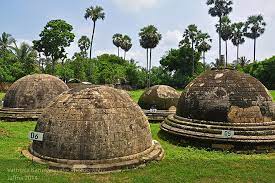Extraordinary ruins of Kadurugoda Temple in the Northern Province
By Arundathie Abeysinghe

 Located approximately 10 kilometers from Jaffna City, Kadurugoda Temple and Ruins are found on the outskirts of Jaffna city in Kantarodai. The Temple and ruins are one of the few remaining Buddhist legacies in the Northern province. In 1917, Jaffna Magistrate Paul E. Peiris reported that bricks from the location of the Temple were being carried away in cart loads by residents in the locale to construct houses. Magistrate Peiris has documented approximately 60 gray coral-stone dagobas (stupas) at the site. Yet, at present there are approximately 20 stupas sprawled across an acre of open land under palmyrah trees (Borassus flabellifer).
Located approximately 10 kilometers from Jaffna City, Kadurugoda Temple and Ruins are found on the outskirts of Jaffna city in Kantarodai. The Temple and ruins are one of the few remaining Buddhist legacies in the Northern province. In 1917, Jaffna Magistrate Paul E. Peiris reported that bricks from the location of the Temple were being carried away in cart loads by residents in the locale to construct houses. Magistrate Peiris has documented approximately 60 gray coral-stone dagobas (stupas) at the site. Yet, at present there are approximately 20 stupas sprawled across an acre of open land under palmyrah trees (Borassus flabellifer).
According to locals, the name “Kadurugoda” had derived from “Kandavurugoda” (in Sinhala meaning location of a military camp) which was adopted as “Kantarodai” by the resident Tamil population of the locale.
A unique feature of this temple is the existence of small multiple stupas, instead of the usual single large stupa. According to folklore, these stupas had been constructed enshrining the remains of 60 *Arhat Bhikkus who passed away while fleeing the harassment of King Sangili who ruled the Jaffna Peninsula during that period.
The stupas of the Temple possess unique features not found anywhere else in Sri Lanka. They have been constructed of gray colored coral stone. These ancient stupas do not possess the standard square shape portions above the dome found in the majority of stupas in Sri Lanka, instead umbrella shaped fixed pinnacles. These stupas have a very distinguished design with small cavities all over them. The largest stupa is approximately 23 feet (approximately 7 meters) in diameter and the smallest stupa is about 6 feet (approximately one meter). Most of the stupas have only the foundation.
The Temple has been founded during the *Anuradhapura Era. According to stone scriptures in the Temple premises, the Temple has been a significant site.
According to scholars, Kadurugoda Viharaya has been one of the places *Arhat Sangamitta had visited during her journey from *Dambakolapatuna to Anuradhapura to deliver the sapling of the *Sri Maha Bodhi to *King Devanampiyathissa (Reign: 247 BC – 207 BC).
During excavations carried out by the Department of Archaeology from 1917-1919, remains of a shrine room, parts of Buddha Statues, Bodhisattva Statues, foot imprints of the Buddha and coins belonging to pre-Christian era had been unearthed.
According to interlinear inscriptions read by *Professor Senarath Paranavithana, Kadurugoda Temple was constructed by a prince of the *Shailendra Dynasty of the Sri Vijaya Kingdom.
At present, the Temple has been declared an archaeological site protected and maintained by the Sri Lankan army.
Location: Hunugama (Chunnakam) – Minipe (Manipai) Road about 02 kilometers from Hunugama
- Anuradhapura Era- This was a period in the history of Sri Lanka from 377 BC -1017 AD when the Anuradhapura Kingdom was established as the first kingdom in ancient Sri Lanka. King Pandukabaya (474 BC – 367 BC) was the first monarch to rule Sri Lanka from Anuradhapura from 377 BC. Buddhism played a major role during the Anuradhapura Period.
- Arhat – According to Buddhism, an Arhat is one who has attained *Enlightenment and gained insight into the true nature of existence and achieved *Nirvana.
- Arhat Sangamitta Theri – The historical arrival of Arhat Sangamitta Theri was in the 3rd century B.C. shortly after the official introduction of Buddhism to Sri Lanka by Arhat Mahinda, the brother of Arhat Sanghamitta. Her arrival also paved the way for the establishment of the Order of Bhikkuni (Bhikkuni Sasana) in the country. Under the auspices of Emperor Asokha, Arhat Sangamitta Theri and retinue had arrived in *Dambakola Patuna Port with the *Bo sapling which was placed in a golden bowl.
- Borobudur – A 7th-century Mahayana Buddhist Temple located in Central Java, Indonesia. It is the largest Buddhist Temple in the world. The Temple ranks with Bagan in Myanmar and Angkor Wat in Cambodia as one of the great archeological sites of Southeast Asia. The Temple consists of nine stacked platforms, six square and three circular, topped by a central dome. Borobudur is a popular pilgrimage site. Buddhists in Indonesia celebrate Vesak Day at the monument.
- Bo sapling –The sapling of the Bodhi tree or Bo tree is the specific sacred fig tree (Ficus religiosa) under which the Buddha (Siddhartha Gautama) sat when the Buddha attained Enlightenment at Bodh Gaya in Bihar, India. Ficus religiosa is a species of fig tree native to the Indian subcontinent. Bodhi Tree is also known as the “tree of awakening”. Other sacred Bodhi trees with great significance are Anandabodhi Tree at Jetavana in Sravasti, North India and Sri Maha Bodhi Tree in Anuradhapura, Sri Lanka, believed to have been propagated from the original Bodhi Tree.
- Dambakola Patuna – Port of Jambukola or Dambakola Patuna is an ancient port in the Northern Province, Sri Lanka. After Arhat Mihindu Maha Thero brought Buddhism to Sri Lanka in 250 BC, his sister, Arhat Sanghamitta Theri arrived in Sri Lanka with a Sacred Bo Sapling one year later at this port. The temple Samudda-panasala (also known as Jambukola Viharaya) has been constructed commemorating the arrival of the Bo sapling by King Devanampiya Tissa (250-210 BC). Later, King Devanampiya Tissa planted a shoot of the Sri Maha Bodhi Tree at the same location where he kept the original tree before bringing it to Anuradhapura. King Vijayabahu I (1070 – 1110) has restored this site.
- Enlightenment – In Buddhism, Enlightenment is when a Buddhist finds the truth about life and stops being reborn as he/she has reached *Nirvana.
- King Devanampiyathissa (Reign: 247 BC – 207 BC) – Tissa who later became Devanampiya Tissa was one of the earliest kings of Sri Lanka based at the ancient capital of Anuradhapura. Considered as the Great Buddhist Monarch of the Anuradhapura Kingdom, his reign was noteworthy due to the arrival of Buddhism in Sri Lanka under the aegis of the *Mauryan Emperor Ashoka.
- Mahayana Buddhism – Developed from Theravada Buddhism or Hinayana Buddhism (in Sanskrit meaning “small vehicle”, the term given by followers of Mahayana Buddhism to the more conservative school of early Buddhism, Theravada Buddhism).
- Mauryan Emperor Ashoka – Also known as Ashoka the Great was an Indian Emperor of the Maurya Dynasty who ruled almost all of the Indian subcontinent from c. 268 to 232 BCE. Emperor Ashoka ruled the vast and diverse Mauryan Empire through a centralized policy of dharma which favored peace and tolerance. Ashoka also promoted the spread of Buddhism across ancient Asia.
- Nirvana – It refers to a release from the cycle of death and rebirth, the ultimate spiritual goal of Buddhism.
- Professor Senarath Paranavitana (1896 – 1972) – Pioneering archeologist and renowned epigraphist of Sri Lanka, his works dominated Sri Lankan archaeology as well as history during the middle-part of the 20th century. In 1940, he assumed duties as the Commissioner of Archeology.
- Shailendra Dynasty – Also known as Sailendra, or Çailendra, Indonesian Śailendra, or Sjailendra (meaning “Lord of the Mountain”), it is a dynasty that flourished in Java between 7th and 13th centuries in what is at present known as Indonesia after the fall of the Funan Kingdom of mainland Southeast Asia. The Dynasty was marked by a great cultural renaissance associated with the introduction of *Mahayana Buddhism and attained a high level of artistic expression in the many temples and monuments constructed under its rule. During the reign of one of its kings, the famous stupa of *Borobuḍur was constructed.
Image courtesy – cimicjaffna.lk







